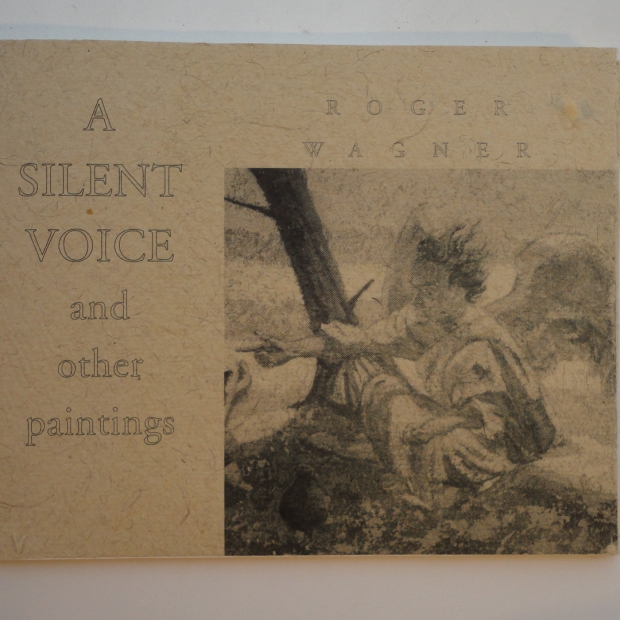Work > Articles
A Silent Voice Alan Powers 1999
A SILENT VOICE - FOREWORD
Roger Wagner's painting The Harvest is the end of the world and the reapers
are angels, 1984, has become established as a classic image of religious
painting of the late second millenium. It is a painting without artifice, the
most transparent statement of a vision that could be imagined, something
everyone can understand. It is not surprising, therefore, that it is in
almost weekly demand as a book cover image, a magazine cover illustration or
some other form of reproduction. When it was exhibited there the Ashmolean
Museum sold more postcards of this painting than of all their Poussins.
This quality of directness is never absent from Wagner's paintings and
engravings. A curator in a hundred years' time might hang The Harvest in the
same room as paintings from the 1970s by the Brotherhood ofRuralists, and
there would be a recognisable affinity of date and spirit, but Wagner is a
younger painter than David Inshaw or Graham Ovenden, with reasons of his own
for painting the way he does. His meticulous technique of mixed media on
paper has the kind of painstaking quality that visionaries like Samuel Palmer
or David Jones tended to employ - stitching closely over a small area but
never losing sight of the whole. To paint a passable representation of
anything can too readily be hailed today as the upholding of tradition but not
many representations have true imagination behind them.
Wagner's directness has much in common with the music of John Tavener, an
artist of an older generation, who reached maturity with Prayer for the World,
1980, followed by Ikon of Light, 1983 and The Protecting Veil, 1987, during
the same period that Wagner was painting The Harvest. Benjamin Britten had
percipiently noted of Tavener and others of his generation in 1969 that they
were 'swinging far, far away now from what I call the academic avant-garde,
who have rejected the past. He and many others adore the past and build on
the past.' Britten was more a post-modernist than a modernist in his attitude
to the past. What distinguishes Tavener and Roger Wagner, in his medium, is
their ability to engage with the past without loss of immediacy, so that 'the
pastness of the past', as T. S. Eliot called it, ceases to matter, a
transformation that Britten's generation found almost impossible.
Take the example of John Piper, the artist with whom Britten most closely
associated himself. Piper painted landscapes and buildings and designed
stained glass for churches, but his 'religious' works remain essentially
decorative, with a suspicion of pastiche. In 1937 in his essay, 'Lost, a
valuable object', he wrote
Of how the warring abstractionists and surrealists of that moment both had 'an
absolute horror of (the object) in its proper context. The one thing neither
of them would dream of painting is a tree standing in a field. For the tree
standing in the field has practically no meaning at the moment for the
painter. It is an ideal, not a reality.' Curiously, that tree standing in a
field was one thing that Piper was never able to paint. Like Britten's remark
about Tavener, he recognised the value of something he could not do himself,
but I like to think Wagner's Trees of Life as a late delivery on Piper's
order.
Many of Wagner's paintings, including The Harvest, are located in the
hinterland of the Suffolk coast, Britten's own patch, where the artist spent
his summer holidays. It is a part of England where the relationship of earth
and sky is always particularly evident. Wherever he has travelled, whether to
Syria or the plains of Didcot, Wagner has recaptured this sense of
relationship. It is not surprising that he should paint a cycle of works on
the subject of St. Symeon Stylites, that great interpreter of architectural
form, which seem innocently topographical until one realises that this is the
view of the person bound to a pillar between heaven and earth. The work of a
topographical painter often demands something of the same sacrifice of
endurance and immovability, anchored to the earth and under the sky.
Sometimes water becomes the mediating element, as in 'The Calming of the
Storm'. This makes visible the paradox of energy and stillness which
scientists are finally identifying in their terms as the central mystery of
the world.
Trees that stand alone have magic properties in legend. 'The Tree of Life'
stands up against the sky, amid the barley. Although this specific setting
for a tree is probably the accidental gift of late twentieth century
agricultural policy in England, it represents one of the oldest and deepest
symbols of man's place between heaven and earth. It is a World Tree, which is
an image of the Cross, one manifestation of the vertical axis between heaven
and earth, through which a two-way communication can be established. The
Elijah paintings make this clear, for the angel visited Elijah while he is
under the juniper tree, which stands centrally in the first three pictures.
In first of the series of Telanissus paintings, the tree occupies the place
that is later taken by the ruins of sacred buildings, as nature is subsumed in
culture.
In these paintings, Wagner has managed to bring the ideal and the reality,
which Piper rightly identified as being sundered in his time, into one,
something which he probably could not have done without his strong religious
beliefs. Paul Nash achieved the same thing, although he needed a more obvious
quality of dislocation to achieve it and only the recent exegesis of Nash's
Event on the Downs, 1932 and similar works by Mary Beale has helped us to
understand that these are not works of personal whimsy, but deeply informed by
religious traditions of East and West.
Mircea Eliade wrote in 1957, The modern Occidental experiences certain
uneasiness before many manifestations of the sacred. He finds it difficult to
accept the fact that, for many human beings, the sacred can be manifested in
stones or trees, for example. But what is involved is not a veneration of
the stone in itself, a cult of the tree in itself. The sacred tree, the
sacred stone are not adored as stone or tree; they are worshipped precisely
because they are hierophanies, because they show something that is no longer
stone or tree, but the sacred, the ganz andere.'
The Sacred, although present in contemporary art well beyond the category of
overtly religious painting, is still a subject not easily discussed, which
explains why it has taken so long to reach an understanding of Nash's
paintmg. Modem Christian painting often has something unsatisfactory about
it, an excess of individualised emotion and a failure of objectivity. The
prcscntation of Wagner's work, on the other hand, in his limited edition
books, catalogues and exhibitions leaves nothing mysterious. We are told
everything we need to know about each picture, and the images themselves do
not rely on obscurity or concealment for their effect.
The stories he chooses from the Bible are often those which concern the
elements. He treats the story of Elijah as narrative sequence, reminding us
how similar the predellas panels of Italian altarpieces are to cartoon strips.
Laurence Whistler, an artist with whom Roger Wagner shows frequent affinity,
once borrowed this 'comic' graphic technique for an engraved glass bowl of
1974 and called it 'Serious Strip', although being a bowl it makes a repeating
story in the form of a ring. Wagner's cycle of paintings from the Book of
Job, exhibited in 1997, created magnificent 'think bubbles' above and below
the protagonists, who are seated on the hard earth under the vault of the
heavens, literally illuminated by their thoughts.
This is not like the coy updating and relocating of Stanley Spencer's Biblical
stories, although like Spencer he helps us to believe that an angel could be
beside us when we wake from sleep, ordering us to eat and get on with the
Lord's work. It is more like the relationship between word and image that
existed in the renaissance, as reconstructed by Michael Baxandall in his book
Painting and Experience in Fifteenth Century Italy. Baxandall describes a
culture in which a preacher could conjure up images in the mind of the
listener, images in which every element contributed to the structured unity of
the story. The Western turn towards naturalistic representation at that time
still contained enough of the intensity and wonderment of the old icon
painting tradition to keep mannerism and triviality at a distance. Roger
Wagner grew up surrounded by the remnants of the fine collection of gold-
round paintings which a cousin presented to the National Gallery, so the link
is not surprising. His father, Sir Anthony Wagner, was the Garter King of
Arms, the senior herald of Britain, upholding a living tradition of emblematic
art. Should we see another layer of meaning in Roger's Tree of Life' in
terms of heraldry, 'a tree proper on a field or and azure': a Universal Tree.
Alan Powers

